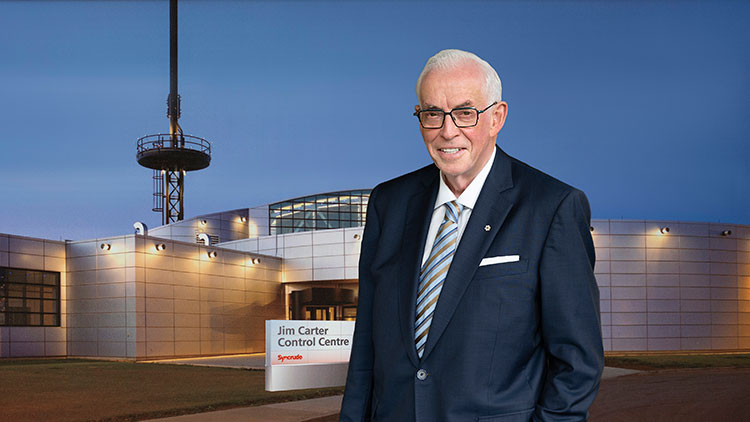Non-urgent government operations are closed December 24 to January 1, reopening January 2. View available services during this period.

“I always said we were building a company, we were building an industry, and we were building a community at the same time. They all went together. You couldn’t have one without the other. There’s an interrelationship that must be present for success.”
Jim Carter of Edmonton is a giant in the history of Canada’s oil sands and an exemplary leader in their sustainable development. This modern pioneer transformed the fledgling industry, and the frontier town of Fort McMurray, into a powerful economic engine for the nation, while building Syncrude Canada into one of the world’s largest and most successful energy producers. His support for building a skilled workforce and creating opportunities for Indigenous people makes him an extraordinary community builder.
James Edward Clarke Carter was born on February 4, 1950, in Glasgow, Scotland, to James and Jean Carter. James Sr. was a successful farmer, and Jean was a homemaker and an active volunteer in their community. Jim was the second eldest of five children with older sister Elizabeth and younger brothers Ian, David, Alan and Andy.
In 1959, when Jim was nine, the family emigrated to Canada, where James Sr. would manage a dairy farm on Prince Edward Island. As early as 12 years old, Jim spent a great deal of time working on the farm, repairing farm machinery and vehicles. “Farming is a challenge, because you’re always making improvements, you’re always testing. Starting out life on the farm contributed almost as much to my success as my engineering degree,” he says.
Jim studied engineering at the University of Prince Edward Island and the Technical University of Nova Scotia, now Dalhousie Engineering, where he earned his Bachelor of Mining Engineering degree in 1973.
After graduating, Jim worked for the Iron Ore Company of Canada in Labrador for a couple of years, then accepted an offer from McIntyre Mines’ coal mine in Grande Cache. He did well and was quickly promoted through the ranks. At 27, he became surface mine manager of the open pit with 400 employees. In 1979, Jim was invited to join the Syncrude team to start the overburden operations team. He accepted the challenge.
He made the controversial decision to double the capacity of the trucks, which introduced innovative drive systems, and to develop the world’s largest shovels. The trucks performed exceptionally well. Eventually, Syncrude’s entire mining operation converted to the trucks and shovels, thanks to Jim’s innovative solutions.
He was just 29 years old, one of the youngest managers at Syncrude, and had already changed the industry. But he didn’t stop there. Jim and his team developed double-roll crushing technology to reduce the massive lumps of oil sands. That was the link they needed to achieve an even bigger innovation in separating bitumen from the oil sands. Jim’s operations team, along with the research team, tried mixing the oil sand with water and pumping it through a pipeline. The constant motion through the pipeline caused the bitumen and sand to separate naturally. The new hydro-transport system would reduce the energy required to produce a barrel of bitumen by 40% with the associated environmental and economic benefits. The technology would be commercialized and adopted by all oil sands companies in Alberta, ensuring the future of the oil sands.
The success led to a series of promotions for Jim as he tackled a variety of challenges throughout Syncrude. In 1987, he completed the intensive Advanced Management Program at Harvard Graduate School of Business Administration. Shortly after, he became Vice President of Finance and Administration, putting him on the executive track. He considers the following two years at Syncrude to be his “on-the-job MBA.” Jim says this, along with the exceptional people with whom he worked, underpinned his many promotions.
Jim served as Syncrude Canada’s President and Chief Operating Officer from 1997 to 2007, a period of significant growth for the company. He worked hard to ensure all communities were partners and participants in the growth of the energy sector. Syncrude became the single largest employer of Indigenous people and a global model of inclusive business development. Over the years, he repeatedly combined the goals of improving Indigenous relations and improving sustainability.
In 1993, Jim met Lorraine Bray as she was completing her Ph.D. in psychology at the University of Alberta. The two married in 1997 and combined their families from previous marriages: Jim’s two children, Andrea and Allan, and Lorraine’s four children, Jonathan, Jessica, Rachael and Jordan. With the youngest four still in high school, it was a busy time for the family.
Jim served on the board for 12 years with the Mining Association of Canada, including two as board chair. He was a driving force behind creating and launching the “Toward Sustainable Mining” program, through which member companies pledged to demonstrate progress in Indigenous employment and environmental sustainability. The program is now a global standard for the mining industry.
As a director of the Alberta Chamber of Resources for over 20 years, Jim was instrumental in ensuring resource sectors worked more closely together and adopted integrated land management practices, resulting in a significantly reduced industrial footprint on the land. In 1992, under the auspices of the chamber, he rallied Alberta’s mining industry to save the Mining Engineering program at the University of Alberta, which was in danger of being shuttered. By founding and chairing the Mining Industry Advisory Committee, Jim ensured the program would become one of the largest and most well respected in the world.
Jim was invited to join the Keyano College Board of Governors in Fort McMurray. He knew Syncrude would need engineers and good tradespersons as the oil sands ramped up, and so began Keyano College’s Co-op Apprenticeship Program in 1992. More than 2,000 young people have completed the co-op program. In 1997, it became the foundation for CAREERS: The Next Generation, co-founded by then Syncrude President Eric Newell (AOE 2004) and Jim, who still serves as board chair. The province-wide program has introduced more than 500,000 high school students to careers in the skilled trades and provided pathways and paid internships to help them find their dream jobs.
While on the Keyano College board, Jim turned down the traditional stipend paid to board members, instead directing the funds into a scholarship named the James Carter Senior Memorial Engineering Award to honour the memory of his father. Jim also established the Dr. Jim Carter Syncrude Mining Scholarship at the University of Alberta, and he and Lorraine established an endowed scholarship at the University of Prince Edward Island.
When Jim retired in 2007, then Premier Ed Stelmach (AOE 2020) asked him to create and lead the Alberta Carbon Capture and Storage Development Council. Jim also served on the board of Climate Change and Emissions Management Corporation, Alberta Research Council and as vice-chair of Alberta Treasury Branch.
Since Jim’s retirement, he has shared his corporate governance leadership as a director for companies that influence the Alberta economy. These include Finning International, Ellis Don Construction, Irving Oil and Brand Industrial Services. In recognition, he was inaugurated as a Fellow of the Institute of Corporate Directors in 2019.
Jim brought his community-building leadership with him when he and Lorraine retired to Edmonton. He served a nine-year term on the board of directors for the Edmonton Symphony Society/Francis Winspear Centre for Music, including a three-year term as chair. Since then, he has continued to serve on a committee that oversees the Winspear Centre’s expansion project.
For the enduring legacies of his career and service, Jim has received more awards and recognitions than space here allows. He has received three honorary doctorates from universities across Canada: Technical University of Nova Scotia (1995), University of Alberta (2004) and University of Prince Edward Island (2008). He has been inducted into three halls of fame (Canadian Petroleum, Canadian Mining and Alberta Business) and received multiple awards from the Canadian Institute of Mining, Metallurgy and Petroleum, and the Association of Professional Engineers and Geologists of Alberta (APEGA). He is a registered professional engineer in Alberta, a lifetime member of APEGA and a Fellow of the Canadian Academy of Engineering. Jim has received the Alberta Centennial Medal, the Queen Elizabeth II’s Diamond Jubilee Medal and the Queen Elizabeth II’s Platinum Jubilee Medal (Alberta). In 2014, he was made an Officer of the Order of Canada.
Jim and Lorraine live on an acreage near Edmonton. Every winter, Jim builds an 84’ x 24’ ice rink for the family, which has expanded to include 20 grandchildren and one great grandson. He also fires up one of his antique tractors to pull a sleigh for rides.
